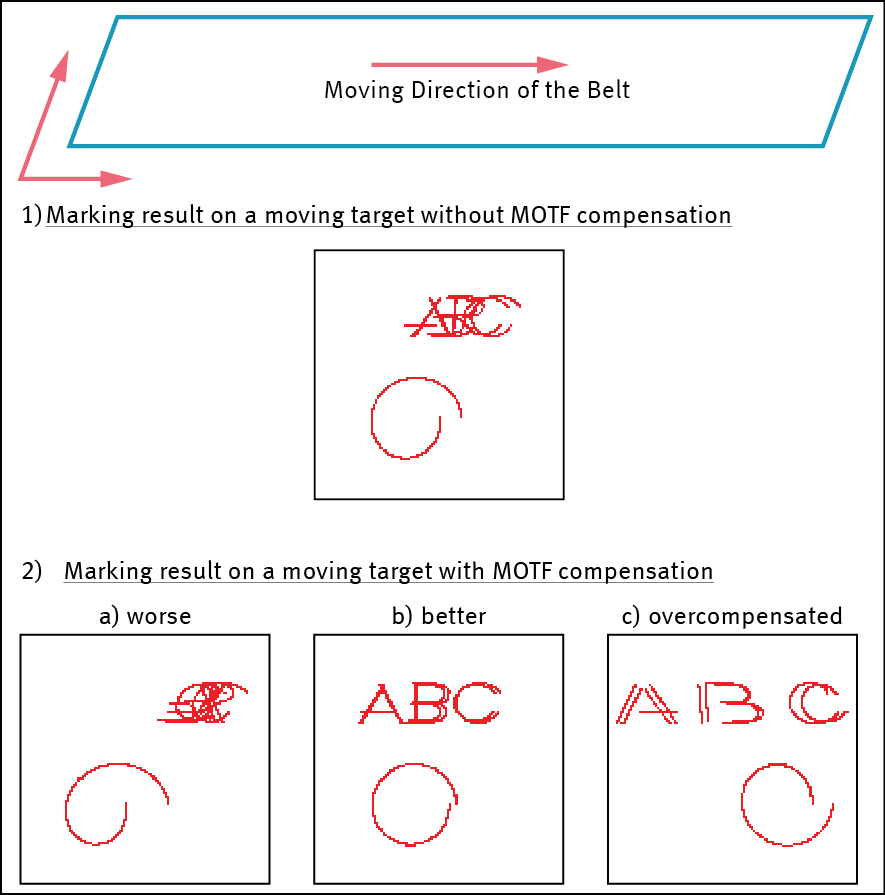|
<< Click to Display Table of Contents > USC-1 Specific Calibration - MOTF |
  
|
|
<< Click to Display Table of Contents > USC-1 Specific Calibration - MOTF |
  
|
Before starting with any Marking On The Fly application, the optic system needs to be well-calibrated in the static situation (no belt movement).
Then, essentially two points need to be checked and adapted:
•MOTF compensation (value of the MOTF multiplier)
•direction of the MOTF compensation (sign of the MOTF multiplier)
1. Check the proper alignment of the scanning field and the scanning direction?
•This can be tested e.g. with marking one line in the moving direction without moving the belt and marking a single point (with a mark loop count of -1) with the slowly moving belt on top of the last marking.
•If the alignment is not good, this can be solved by adjusting the hardware setup or within the correction file.
2.Mark without MOTF settings (without compensation) in SAMLight:
•Start the belt in the default direction with a slow movement.
•Mark ABC-circle.sjf. It is OK, if the marking result is not good because this marking is a reference to compare with a marking with MOTF compensation (see 357 1)).
3.Activate the MOTF compensation in SAMLight:
•Activate SAMLight → Settings → System → Optic → Advanced: Marking on the Fly by clicking on the checkbox 'Enable'.
•Select Channel 0 or Channel 1 according to the electrical connection of the encoder.
•Select X-Channel or Y-Channel according to the movement direction of the belt. Note: due to a flip in the optic settings the correct channel might be not obvious.
•As a starting value, set the multiplier to the value which can be calculated following the formula here.
•Leave the dialog with OK.
4.Tuning of the MOTF multiplier by marking with MOTF settings (with compensation) in SAMLight:
•Start the belt in the default direction with the same slow movement as in 2.
•Mark a job like ABC-circle.sjf. Compare the marking result with the result in 2.
Is the marking result getting better with compensation or getting worse? This can be easily seen when looking at the gap of the circle. There are 3 different cases (see figure 357 2)).
oIf the result is getting worse (see figure 357 2)a)) - e.g. the start and end of the circle are farther apart, change the wiring of your encoder or change the direction of the compensation by changing the sign of the MOTF multiplier value. See table "USC-1 MOTF settings for different setups" for more details.
oIf the result is getting better (see figure 357 2)b)) - e.g. the start and end of the circle are coming closer, adjust the MOTF multiplier.
oIf you run into overcompensation (see figure 357 2)c)) - e.g. the start and end of the circle changed orientation in the direction of the movement, fine tune the MOTF multiplier.

Figure 357: Different cases of MOTF compensation. For a moving belt to the right, an example of a marking result of ABC-circle.sjf without MOTF compensation is shown in 1). When the MOTF compensation is activated in SAMLight, the marking result depends on the precise value of the MOTF multiplier. Three different marking results for three different MOTF multiplier values are shown in 2).
5. Mark with MOTF settings a job containing 2 entities separated by a ScMotfOffset entity.
•Create a job containing 2 entities, e.g. two vertical lines and center both entities in x and y. Add a ScMotfOffset entity at the beginning and specify a certain distance, e.g. 10mm. Add a ScWaitForTrigger entity after the first line entity, see figure 358 a).
•Start the marking. Are both entities marked?
oIf you are just seeing the first entity, change the checkbox invert Offset in SAMLight. See table "USC-1 MOTF settings for different setups" for more details. "
•Is the distance between the entities as specified within the ScMotfOffset entity (see figure 358 b) for visualization)?
oIf not, it could be that the marking time of the first entity was too long for the offset. Try with a larger offset or faster marking speed or smaller entity. Alternatively, the initial external trigger was applied longer than the corresponding offset time. Another possibility is that the 2D calibration of the static setup or the MOTF multiplier is not yet optimal.

Figure 358: a) Example job containing 2 lines, ScMotfOffset and ScWaitForTrigger. b) Visualization of the marking of a) where the distance between the entities (lines) is defined by the value of the ScMotfOffset entity.